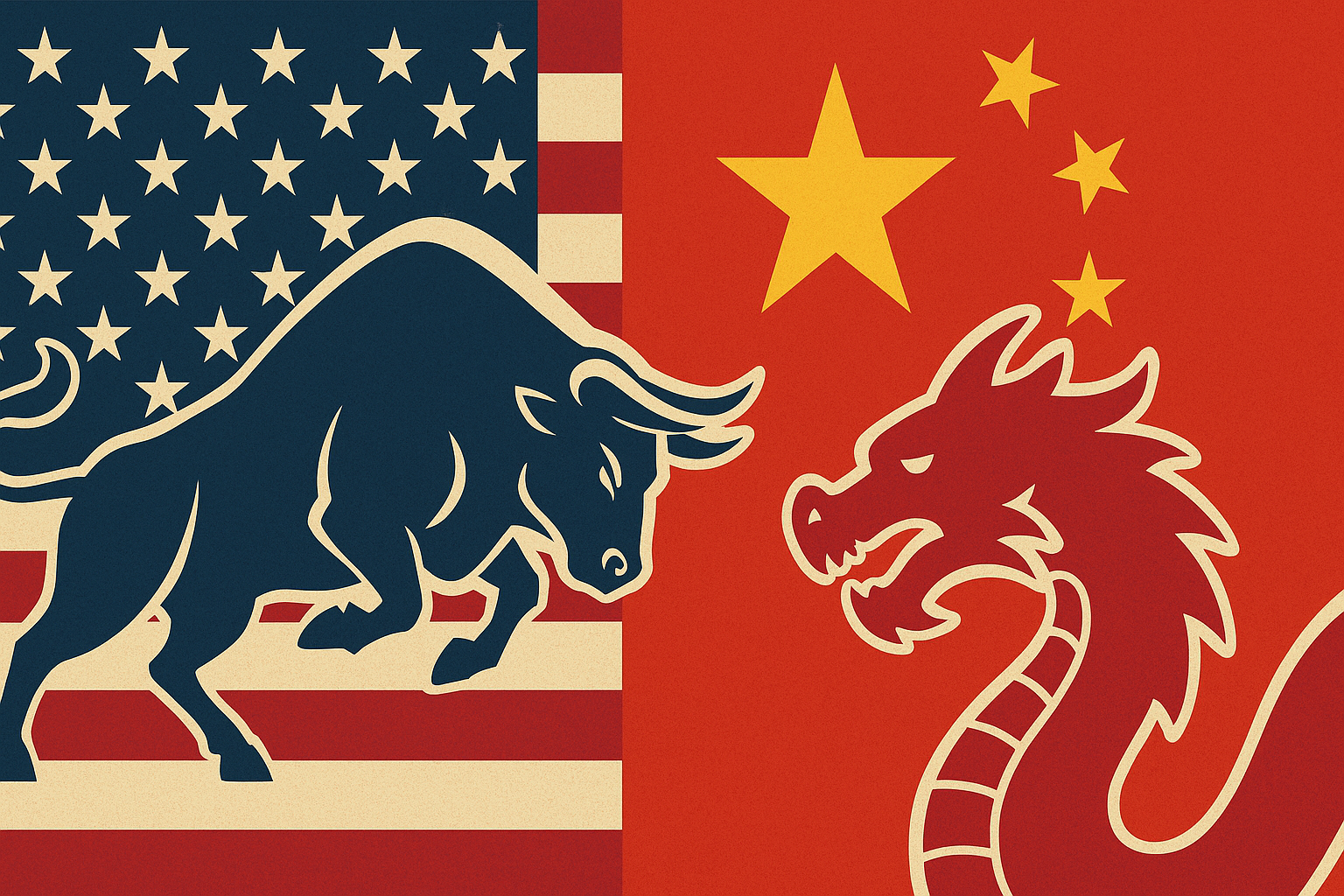
28 Jul America vs China: The Battle for Global AI Leadership
In a pivotal week for global technology, the White House released “Winning the Race: America’s AI Action Plan” on July 23, 2025, setting out a deregulatory, competitiveness‑first roadmap for U.S. AI leadership. (White House, July 23, 2025) [PDF] Three days later, on July 26, 2025, at the World Artificial Intelligence Conference (WAIC) in Shanghai, Beijing published the full text of its “Artificial Intelligence Global Governance Action Plan”, emphasizing multilateral cooperation and equitable access. (Gov.cn full text, July 26, 2025) (English.gov.cn)
These documents sketch contrasting visions. The U.S. plan prioritizes rapid innovation and national security to “win the AI race,” while China frames AI as a shared international resource aligned with UN processes. For senior executives, this divergence has practical consequences: U.S. deregulation may accelerate domestic deployment, while China’s inclusive framing could broaden opportunities across emerging markets—raising the odds of split standards and supply chains.
1 — Origins & Stated Objectives
United States. The plan explicitly casts AI as a national‑security race and cites the goal of “unquestioned and unchallenged global technological dominance.” It is organized around three pillars: Accelerate AI Innovation, Build American AI Infrastructure, and Lead in International AI Diplomacy & Security, and follows Executive Order 14179 (“Removing Barriers to American Leadership in AI”). [PDF] (EO 14179)
China. The plan presents AI as an international public good guided by principles including benefiting people, respecting sovereignty, development‑orientation, safety and controllability, fairness and inclusiveness, and open cooperation, and situates implementation within the UN’s Future Summit and its Global Digital Compact. It also calls for “AI+” integration across industries. (Gov.cn full text)
Takeaway. Washington starts from competition and speed; Beijing starts from order and inclusion.
2 — Scope & Architecture
United States (3 pillars → c.~90 actions). The plan details scores of near‑term policy steps: deregulation, streamlined federal procurement, expanded AI evaluation, defense adoption, permitting reform for data centers and fabs, grid upgrades, and tightened export controls. (Reuters) [PDF]
China (13 action areas). The framework sets out thirteen domains: accelerating innovation; empowering industries; interoperable compute and data‑center buildout; open‑source ecosystems; high‑quality data; green/energy‑efficient AI; standards; public‑sector adoption; safety governance; UN‑anchored multilateralism; global capacity building; and multi‑stakeholder participation. (Gov.cn full text)
Note on compute targets: China’s 300+ EFLOPS by 2025 target derives from a separate October 2023 national compute‑infrastructure plan (not the July 2025 governance plan). (Reuters, Oct. 9, 2023) (English.gov.cn)
| Aspect | U.S. Plan | China Plan |
|---|---|---|
| Focus Areas | 3 pillars: Innovation, Infrastructure, Diplomacy/Security | 13 domains: Innovation, Governance, Infrastructure, Global Cooperation |
| Key Metrics | ~90 near‑term policy actions | Separate 2023 plan targets >300 EFLOPS compute by 2025 |
| Scale | National; alliance‑centric | Global; UN‑aligned; emphasis on Global South
|
3 — Governance Philosophy & Ideological Posture
United States. Agencies are directed to remove “onerous regulation,” review FTC actions for undue burdens, and revise the NIST AI Risk Management Framework to eliminate references to misinformation, DEI, and climate change. Procurement guidance favors systems that are “objective” and free from top‑down ideological bias. [PDF]
China. Emphasis falls on standards, fairness, sovereignty and risk management (classification, testing, threat‑information sharing, traceability) within interoperable frameworks grounded in international law. (Gov.cn full text)
Related U.S. executive orders (July 23, 2025): Preventing “Woke” AI in the Federal Government; Promoting the Export of the American AI Technology Stack; Accelerating Federal Permitting of Data Center Infrastructure.
4 — Open‑Source & Access
United States. Strong support for open‑source/open‑weight models (including NAIRR pilots, compute‑access market concepts, and NTIA‑led SME adoption) to spur startups and research. [PDF]
China. Calls for cross‑border open‑source communities, compliant open‑source ecosystems, and openness of non‑sensitive resources to improve stack interoperability—especially benefiting developing countries. (Gov.cn full text)
Example. Open‑weight releases like DeepSeek‑R1 illustrate China’s growing presence in open ecosystems. (DeepSeek‑R1 GitHub) (DeepSeek announcement)
5 — Compute, Energy & Physical Infrastructure
United States. The plan prioritizes expedited permitting for data centers, fabs, and energy infrastructure; grid expansion; secure facilities for defense; and onshoring semiconductors. [PDF]
China. The governance plan urges clean power, intelligent compute, unified compute standards, and support for Global South infrastructure access. (Gov.cn full text) (For the separate national compute target see: English.gov.cn, Oct. 2023.)
Investment baseline. U.S. private AI investment reached $109.1B in 2024 vs. $9.3B in China. (Stanford HAI AI Index 2025) [Report PDF]
6 — Data, Privacy & Safety
United States. Focus on evaluation ecosystems, interpretability/robustness, and biosecurity; expand export‑control enforcement; and evaluate PRC frontier models for alignment with censorship/propaganda. [PDF]
China. Proposes risk classification, testing, incident response, data protection, and traceability to curb misuse. (Gov.cn full text) (Analysts continue to document censorship concerns in some Chinese models.) (arXiv, June 2025) (USCC, 2024)
7 — International Strategy
United States. Export the “American AI tech stack,” counter Chinese influence in standards bodies, tighten controls on compute/semiconductor technologies, and align protections with allies. [PDF] (EO: Export of AI Stack)
China. Proposes establishing a global AI cooperation organization, with Shanghai under consideration for the headquarters, to coordinate development and governance and reduce fragmentation—especially for the Global South. (Reuters) (English.Shanghai.gov.cn)
8 — Workforce & Domestic/Global Adoption
United States. Jobs and living‑standards focus; centers of excellence and sandboxes; sector pilots (e.g., healthcare, energy, agriculture); infrastructure skills. [PDF]
China. Capacity building as a centerpiece of international cooperation (joint labs, shared testing, curated datasets) and public‑sector first‑mover deployments in health, education, and transport. (Gov.cn full text)
9 — Standards & Multilateralism
United States. Lead through innovation and alliances; resist norms perceived to constrain frontier progress; scrutinize PRC models. [PDF]
China. Accelerate standards via ITU/ISO/IEC, reduce algorithmic bias, and establish transparent, interoperable frameworks; supports UN‑anchored mechanisms. (Gov.cn full text)
Why They Differ
- Political economy. U.S.: market‑first, competition‑driven acceleration. China: state‑steered multilateralism aimed at equitable access. (See the U.S. plan’s deregulatory directives and China’s UN‑aligned wording.) [U.S. PDF] [China full text]
- Security vs. sovereignty. U.S.: export controls and alliance hardening. China: sovereignty, non‑exclusion, and UN channels. [U.S. PDF] [China full text]
- Institutional playbooks. U.S.: domestic administrative tools (EOs, procurement, agency guidance). China: building or leveraging international bodies (proposed global AI organization + UN mechanisms). [EO] [Reuters]
Long‑Term Implications
- Standards fragmentation/dual regimes. U.S. alliance‑led technical norms vs. China‑anchored multilateral frameworks could yield parallel standards, raising compliance costs and complicating cross‑border deployment. [U.S. PDF] [China full text]
- Compute & supply‑chain realignment. U.S. efforts to onshore and secure high‑end compute may concentrate frontier capacity within allied networks; China’s push for interoperable compute and Global South access may broaden its influence where capacity is scarce. [U.S. PDF] [China 2023 compute plan]
- Regulatory gravity centers. If China stands up a global AI cooperation body (HQ tentatively in Shanghai), states seeking rule consistency may gravitate there; U.S. partners anchor around export‑compatible norms. [Xinhua via Shanghai.gov.cn] [Reuters]
- Open‑source as battleground. Both champion “open,” but with different ends: U.S. for startup dynamism and research; China for diffusion/equity and influence—expect friction over security, licensing, and content moderation. [U.S. PDF] [China full text] [DeepSeek‑R1]
- Public trust & risk. China’s process‑heavy risk doctrine may establish baseline safety norms; U.S. acceleration could boost breakthroughs but also sharpen debates over bias and safety. [China full text] [U.S. PDF]
Executive Summary
U.S.: Innovation‑first deregulation; infrastructure surge; export‑control diplomacy.
China: Governance‑first, UN‑aligned multilateralism; Global South capacity building; proposed global AI cooperation organization with Shanghai under consideration for HQ. [U.S. PDF] [China full text] [HQ report]
Data Points
- $109.1B vs. $9.3B: U.S. vs. China private AI investment in 2024. (Stanford HAI) [PDF]
- ~70%: China’s share of AI patent grants in 2023 (all AI patents), and ~70% share of GenAI patent families (2014–2023). (Stanford HAI 2025) (WIPO GenAI Patent Landscape)
- >300 EFLOPS by 2025: Target from China’s 2023 compute‑infrastructure plan (separate from the July 2025 governance plan). (English.gov.cn) (Reuters)
Sources
- America’s AI Action Plan (White House PDF, July 2025)
- Artificial Intelligence Global Governance Action Plan (Gov.cn full text, July 26, 2025)
- EO: Preventing “Woke” AI in the Federal Government (July 23, 2025)
- EO: Promoting the Export of the American AI Technology Stack (July 23, 2025)
- EO: Accelerating Federal Permitting of Data Center Infrastructure (July 23, 2025)
- Reuters: China proposes new global AI cooperation organisation (July 26, 2025)
- Xinhua/Shanghai.gov.cn: HQ under consideration in Shanghai (July 27, 2025)
- Stanford HAI AI Index 2025 — Economy (U.S. $109.1B vs. China $9.3B in 2024)
- English.gov.cn: 2023 compute plan (300+ EFLOPS by 2025)
- WIPO: Generative AI Patent Landscape (2014–2023)



Sorry, the comment form is closed at this time.